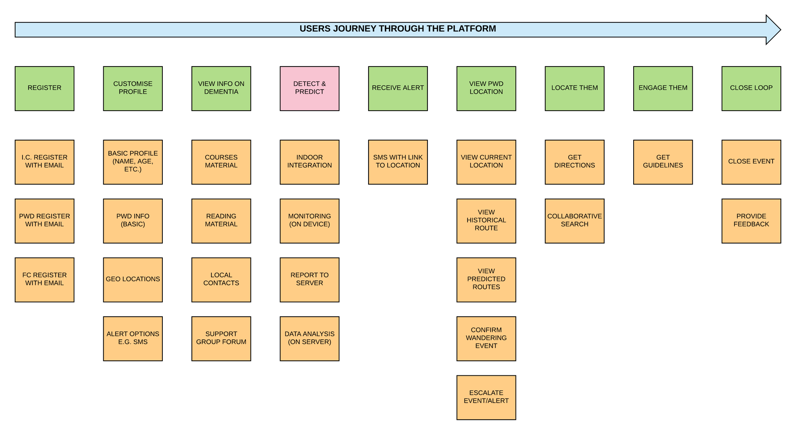From the outset, the Carelink team identified the importance of a user-centred approach as a core philosophical tenet of the design and development process. For this reason, a 2-sided approach to technology design and development planning has been adopted. This user story-mapping process is informed by the work of Jeff Patton and has evolved over a number of stages.
- Initial user requirements and feedback identified through interviews with people with dementia, informal care givers, formal care givers and experts at a number of locations in Belgium and Switzerland. (more on this in our next blog post)
- Based on this feedback, an initial 4 user scenarios for the Carelink platform were prioritised
- [Detect] Find the person with dementia.
- [Predict] Identify a wandering occurrence and predict when a person with dementia might wander.
- [Inform] Inform the carer/community how best to approach/relate to them to successfully deal with such an eventProvide training and support for Carelink platform users including informal caregivers and community members.
- [Integrate/Enhance] Develop an open platform that allows other relevant service providers to integrate.
- Through both individual contributions and collective discussion at a technical team level, and in consortium-wide collaborations the user stories have been developed in a structured format. For each scenario, actors have been identified, user stories enumerated and described with relevant goals and desired outcomes for each story.
- Separately, a user-map, early version in the diagram below, has been developed which identifies platform goals (green) and tasks (orange) in sequential order (the order in which a user would interact with the platform). This map has been further broken down into iterations corresponding to software releases

- Finally, the user stories have been cross referenced against the user map, closing the loop on this 2-sided approach and ensuring that every story has a corresponding task.
This approach has several advantages. The end user is the starting point, informing the design and development process. There is a real emphasis on ‘the story’ and the breadth of that story initially. Who is interacting with the platform? What do they want to do with the solution? Why – what is their desired outcome? The 2-sided approach helps ensure that critical features are not omitted. The sequential, left-to-right ordering of the user-map enables a logical development with linear progression that reflects the relative importance of the scenarios. The horizontal ordering of tasks, linked to specific goals allows for a pragmatic release schedule. Details, variations, alternatives and exceptions populate the body of the map. One of the most important benefits of using stories is a shared understanding. By developing stories around the tasks, eventually the fine-grained development tasks that need to tackled will be identified.
This is, of course, a continuous process which will be revisited with subsequent releases and revised as more feedback and validation comes from the key stakeholders.

